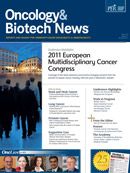Prostate Cancer Test Deemed Unnecessary by Government Panel
After decades of use, a routine test used for diagnosing prostate cancer has come under fire after a government panel questioned its safety.

After decades of use, a routine test used for diagnosing prostate cancer has come under fire after a government panel questioned its safety, causing a controversy among many oncologists, urologists, and others in the medical community as to what is best for the patient.
Diagnostic techniques for various forms of cancer can often be uncomfortable or time-consuming procedures that patients undergo reluctantly and sometimes skip altogether. When it comes to testing for prostate cancer, however, that has not been an issue since the discovery of the prostate-specific antigen, or PSA. The protein is produced by the prostate gland and can be tested for during routine blood tests. The protein is often found in higher levels in men with prostate tumors, thereby making it an important biomarker for the disease.
Or does it? That’s the question that was put forth by the United States Preventive Services Task Force (USPSTF), a panel of nonfederal experts in the prevention of disease. The USPSTF performs extensive scientific reviews of preventive healthcare services, including screening, counseling, and preventive medications. In October, after a rigorous evaluation of the evidence regarding PSA testing, the panel released a draft recommendation that states that “there is moderate certainty that the harms of PSA-based screening for prostate cancer outweigh the benefits,” and the panel “now recommends against PSA-based screening for prostate cancer in all age groups.”1
Because PSA testing has been a routine blood test used to screen thousands of patients over the last few decades, this recommendation has caused oncologists and urologists to take sides. On one side, some firmly believe that the test helps people and the recommendations change nothing. On the other side, others feel that the recommendations were based on sound science and that PSA testing should not be considered the gold standard in prostate cancer screening. Ultimately, patients have been caught in the middle, and new dialogues are taking place as they try to decide what is right for them.
Evidence-Based Science
The USPSTF reviewed a number of large studies before making its draft recommendation. The 2 studies at the center of its decision were the European Randomized Study of Screening for Prostate Cancer (ERSPC) and the US Prostate Lung, Colorectal and Ovarian (PLCO) cancer screening trial.
In reviewing the studies for the USPSTF, the panelists considered the following questions2:
- Does PSA screening decrease mortality?
- Does PSA screening cause harm?
- What benefits exist from treating earlystage or screening-detected prostate cancer?
- What are the harms associated with such treatment?
The PLCO trial randomly assigned 76,693 men between the ages of 55 and 74 to annual PSA screening plus digital rectal examination compared with usual care. After 7 years of follow-up, the study found that PSA screening was associated with increased prostate cancer incidence (relative risk [RR], 1.2; 95% CI, 1.2-1.3), but had no effect on prostate cancer-specific (RR 1.1; CI, 0.75-1.7) or all-cause (RR, 0.98; CI, 0.92-1.0) mortality. Physical harms associated with PSA-based screening included bleeding or pain from digital rectal examination; bruising or fainting due to venipuncture; and biopsy complications, such as infection, bleeding, and urinary difficulties. The PLCO trial also found that after 4 PSA tests, the cumulative risk for at least 1 false-positive was 13%.
The ERSPC trial results, which randomly assigned 182,000 men aged 50 to 74 years from 7 countries to PSA testing every 2 to 7 years or to usual care, found that prostate cancer incidence was higher in the screened group (net increase, 34 per 1000 men), but there was no statistically significant difference in prostate cancer-specific mortality (RR, 0.85; CI, 0.73-1.0). One testing center in Göteborg, Sweden, was excluded because it reported results separately that were not reflective of what was being observed at the other testing centers in Europe. Across the entire ERSPC trial, 76% of prostate biopsies performed for elevated PSA levels found no cancer.
After analyzing the results of the PLCO and ERSPC trials and the results of other studies evaluating PSA testing, the USPSTF found that prostatectomies were associated with a decreased risk in prostate cancer-specific mortality. However, prostatectomies were also associated with urinary incontinence and erectile dysfunction, as well as other surgical complications.
Anger on 2 Levels
The highly publicized release of the USPSTF draft recommendations has led to different reactions from virtually every stakeholder involved in PSA testing. However, the news of the recommendations concerns patients the most, and is prompting many patients to question both PSA testing and the validity of these recommendations.

Leonard J. Gomella, MD
“In my office, we’ve encountered patients with two levels of anger since these results came out,” said Leonard J. Gomella, MD, Bernard W. Godwin Jr professor of prostate cancer and chairman of the Department of Urology at Thomas Jefferson University Hospital in Philadelphia, Pennsylvania. “On one level, I have patients who know that PSA screening was helpful and believe that these recommendations are sending the wrong message. On a second level, there are patients who are scheduled for PSA screening who now think we’re out to harm them.”
Gomella, who was a practicing urologist long before the widespread use of PSA testing for prostate cancer screening, said that he is in favor of continuing to use the screening method. While admittedly biased toward PSA testing, Gomella also criticized the methodology of the USPSTF. Among his chief criticisms is the fact that the 16-member panel does not include either an oncologist or a urologist.
Gomella also cited an important limitation in the PLCO trial. In that trial, 44% of patients had undergone a PSA test prior to enrolling in the trial, resulting in their exclusion from the results.
He also said that he believes the panel was wrong in excluding the Göteborg, Sweden, study. In that particular study, 20,000 men were randomly assigned into 2 groups; 1 received screening and the other did not. The rate of mortality in the group that was screened was 44% lower than the group of men who did not receive screening, a very significant reduction. While the study did not show any clear impact on overall mortality, Gomella believes the study should not have been excluded because the test was based on sound science, even if the numbers were much better than the other European studies.
“
In my office, we’ve encountered patients with two levels of anger since these results came out. On one level, I have patients who know that PSA screening was helpful and believe that these recommendations are sending the wrong message. On a second level, there are patients who are scheduled for PSA screening who now think we’re out to harm them. ”
—Leonard J. Gomella, MD
“[The panel] has completely trashed PSA testing,” Gomella said. “Until we have a new test other than PSA, to say it shouldn’t be done is not fair.”
A study released in October, weeks after the USPSTF’s draft recommendation was made public, confirmed Gomella’s belief that PSA trials help patients. Conducted by researchers at the Mayo Clinic, the study was released at a meeting of the North Central Section of the American Urological Association in California. It found that men in their 40s with a baseline PSA at or above 4.0 ng/mL, with any PSA levels below that amount considered normal, were much more likely to undergo a biopsy and be diagnosed with low-level prostate cancer. Even though 89% of the tumors found were classified as “low risk,” the authors concluded that PSA testing is directly linked to the next appropriate steps in the care of patients with prostate cancer.3
Time for a Change?
While Gomella is among several people in the medical community who do not believe that the USPSTF’s draft recommendation is the final say on the subject, others are wondering if this extensive review by the Task Force is a sign that PSA testing is not as great as it was once thought to be.

Leonard Lichtenfeld, MD
Leonard Lichtenfeld, MD, chief deputy medical officer of the American Cancer Society (ACS) in Atlanta, Georgia, represents one of the key stakeholders who are questioning the validity of PSA testing in light of the Task Force’s recommendation. Even after the release of the draft recommendations by the USPSTF, the ACS still recommends that patients and their physicians discuss the risks and benefits associated with PSA testing prior to having it done, but Lichtenfeld said that the evidence that PSA testing provides a benefit to patients “is just not there.”4
Lichtenfeld said that he thinks there was a “cultural belief” on the part of physicians and patients that PSA tests were saving lives. Before the test came out, a digital rectal examination was the only method physicians had for screening for prostate cancer, which was uncomfortable for the patient and did not necessarily catch every case of prostate cancer. Because PSA testing was easier to perform, “No one was questioning the scientific validity [of the PSA test],” Lichtenfeld said.
Lichtenfeld said the studies that the USPSTF used to make its draft recommendation were sound in that they were large, multicenter studies that followed men over long periods of time. Regarding doctors, Lichtenfeld believes that every physician should seriously consider the data and decide whether or not their patients should get the PSA test.
“What this test can do to a patient’s life is significant,” Lichtenfeld said.
There is a likelihood that men could receive a false-positive test, so even though a patient might not even have prostate cancer, he might experience depressive symptoms and anxiety associated with a cancer diagnosis. Likewise, the decision to undergo a prostatectomy or other forms of treatment can pose more stress and potential side effects to the patient.
“
Even if a patient is diagnosed with prostate cancer, this disease might not ultimately be the cause of death. A person might go through chemotherapy, radiation therapy, and surgery, and endure all of the side effects associated with those treatments, and it might not make a difference in terms of the patient’s outcome. It’s very tough for someone to go through all of that and think that maybe it doesn’t make a difference. ”
—Leonard Lichtenfeld, MD
In addition to the controversy surrounding the ability of PSA testing to save lives in the long term, Lichtenfeld also pointed to a number of negative side effects associated with prostate cancer treatments, including pain, urinary incontinence, proctitis, and impotence.
Even if a patient is diagnosed with prostate cancer, Lichtenfeld said that this disease might not ultimately be the cause of death. A person might go through chemotherapy, radiation therapy, and surgery, and endure all of the side effects associated with those treatments, and it might not make a difference in terms of the patient’s outcome.
“It’s very tough for someone to go through all of that and think that maybe it doesn’t make a difference,” Lichtenfeld said.
While the future of PSA testing might still be up for debate, both Gomella and Lichtenfeld agreed that a better test for prostate cancer needs to come along—one that can assess more accurately just how aggressively a tumor might affect a patient’s life. Before that happens, though, both also agree that discussing PSA testing with each patient and clearly communicating the potential risks involved is the proper thing to do at the moment.
References
- US Preventive Services Task Force. Screening for Prostate Cancer: US Preventive Services Task Force Recommendation Statement. www.uspreventiveservicestaskforce.org/draftrec3.htm. Accessed October 24, 2011.
- Chou R, Croswell JM, Dana T, et al. Screening for prostate cancer: a review of the evidence for the US Preventive Services Task Force [Published online ahead of print October 7, 2011]. Ann Intern Med. www.annals.org/content/early/2011/10/07/0003-4819-155-11-201112060-00375.1.long. Accessed October 24, 2011.
- Mayo Clinic Study: PSA Test Valuable in Predicting Biopsy Need, Low-Risk Prostate Cancer. October 25, 2011. www.businesswire.com/portal/site/home/permalink/?ndmViewId=news_view&newsLang=en&newsId=20111025006893&div=-1212448159. Accessed October 26, 2011.
- Lichtenfeld L. US panel says “no” to PSA screening. http://acspressroom.wordpress.com/2011/10/07/u-s-panel-says-no-to-psascreening. Accessed October 25, 2011.




